Italian voice generation technology is transforming how brands, educators, and content creators reach Italian-speaking audiences with precision and cultural relevance. With AI advancements, it’s now possible to generate high-quality, natural-sounding Italian voice overs that reflect regional accents, whether from Northern, Central, or Southern Italy. These voice overs are suitable for a broad range of applications, including podcasts like E poi il silenzio - Il disastro di Rigopiano, YouTube videos like PANDA BOI, e-learning, and even personalized customer support. This guide will delve into the intricacies of Italian voice generation and showcase top user-friendly Italian AI voice generators to reach a global audience.
About Italian
The Italian language is spoken by approximately 67 million people worldwide and celebrated for its melodic tones and regional dialects. Italian speakers can easily distinguish between accents from different parts of the country, with each region having its own vocabulary, expressions, and even grammatical structures. This diversity adds complexity to Italian voice generation, making it crucial for AI tools to support dialectal differences to deliver authentic and relatable audio. Below are a few examples of regional differences and how Italian AI voice generators can adapt to them.
Northern Italian Accents
In Northern Italy, accents tend to be clearer and more concise, with softer tones compared to the more expressive southern dialects. For instance, Milanese Italian lacks the sing-song intonation common in southern dialects, making it ideal for professional or corporate Italian voice overs that require a neutral and understandable tone. An Italian AI voice generator that captures this clarity is useful for businesses looking to create instructional content or formal audio files for employees or clients in northern Italy.
Central Italian
Tuscan Italian, especially the accent from Florence, is often considered the standard for media and education in Italy due to its balance of clarity and expressiveness. This accent, often used in Italian audiobooks and podcasts, features softer sounds, such as the “soft c” (e.g., “casa” sounds like “hasa”). An Italian speech generator that mimics the Tuscan accent provides an appealing, understandable voice that resonates with a broad audience, enhancing accessibility and user engagement.
Southern Italian Accents
The Southern Italian dialects, including Neapolitan and Sicilian, are known for their rhythmic, melodic qualities and rich vocabulary. These accents often feature a more musical and expressive tone, adding character and warmth to the voice. Italian TTS tools that support these regional accents are ideal for creating authentic voice overs for storytelling, advertising, or other informal projects targeting Southern Italian audiences. This ensures listeners feel connected, as the content resonates with the unique sounds and cadence of their regional speech.
Types of Italian AI Voice Generation
Italian AI voice generators offer two primary options: text to speech (TTS) and voice cloning. Each technology serves unique purposes, and choosing the right one depends on the project’s objectives, target audience, and voice requirements.
Realistic Text to Speech Italian Voices
Italian text to speech software allows users to convert text into spoken Italian audio, providing lifelike text to speech voices for various applications that are indistinguishable from human voices. With advanced AI algorithms and speech synthesis technology, text to speech tools can now replicate Italian voices that sound realistic, covering different regional accents and voice types. For example, a Northern Italian accent, like one from Milan, often has a softer "s" sound and a clearer "o" vowel pronunciation, giving it a more neutral tone suited to business or educational content. On the other hand, a Southern Italian accent, such as from Naples or Sicily, might have a more emphatic intonation and a distinctive "e" vowel sound, lending a conversational warmth perfect for storytelling or entertainment-based voice overs.
Italian Voice Cloning
Voice cloning technology takes voice generation a step further by allowing users to create custom voices that replicate a specific individual’s tone, intonation, and style via machine learning. For Italian-speaking influencers or brands, voice cloning is a powerful tool for maintaining a consistent voice across projects. For example, Fedez, a famous Italian rapper, YouTuber, and podcaster known for his candid style on Muschio Selvaggio, could use voice cloning to maintain his signature tone and delivery across multiple projects. This consistency allows him to appear in various media without needing to record each piece individually, preserving his distinctive natural-sounding voice that fans recognize and trust.
Benefits of Italian AI Voice Generators
Italian, unlike many other languages, features significant regional diversity and distinct pronunciation patterns that enhance its expressive quality. High-quality Italian AI voice generators can replicate these unique characteristics, creating audio that feels authentic and engaging. Here are some of the top benefits of using Italian AI voice generators:
- Affordability: Hiring Italian voice actors for every project or specific regional accent can be expensive, especially for small businesses or content creators who produce frequent updates. Italian TTS offers an affordable alternative, allowing users to create high-quality voices without hiring multiple voice actors for different regions. This is particularly helpful for projects with varying scripts or frequent updates, such as e-learning modules or social media content.
- Scalability: Italian AI voice generators make it easy to scale Italian audio production. Large companies, such as Italian corporations like Eni or Telecom Italia, can use Italian TTS solutions to quickly generate AI voice overs for customer support materials, training sessions, or product demos. The scalability of Italian AI voice generation ensures that companies can meet high demands without compromising on quality or authenticity, helping them reach Italian-speaking audiences effectively.
- Authentic male and female voices: The best Italian TTS generators offer a variety of female and male voices, allowing brands to choose the voice that best fits their brand identity and target audience. For instance, a children’s audiobook might use a warm, inviting female voice, while an instructional video might benefit from a clear, professional male voice. Having access to diverse voice types increases flexibility and enables brands to make a stronger connection with Italian-speaking listeners.
- Regional Italian accents: Italian AI voice generators that offer region-specific accents enable content creators like Davie504 or Chiara Ferragni to engage more authentically with their audience. By allowing users to select accents such as Neapolitan or Milanese, these tools provide a localized experience that enhances cultural relatability. This is invaluable for creators producing content for Italian regions where people are accustomed to their local accents and dialects.
Best Italian AI Voice Generator for Realistic Italian AI Voices
Speechify Studio is a top-rated Italian AI voice generator that excels in providing natural-sounding, customizable Italian voices. Speechify Studio’s Italian accent generator offers an extensive selection of voices and tools that allow users to create high-quality Italian audio content tailored to their needs, whether for podcasts, explainer videos, or advertising. Here is just a brief look at some of its offerings:
- Extensive language library: Speechify Studio supports over 200+ AI voices across languages, including Italian, French, Portuguese, German, Hindi, Dutch, Polish, Japanese, Spanish, and more. This language variety is advantageous for businesses or creators targeting a multilingual audience, as it enables seamless transition between different languages and ensures that Italian voice overs blend smoothly with other language content.
- Region-specific Italian accents: With Speechify Studio’s region-specific Italian accent options, users can select voices that accurately represent Northern, Central, or Southern Italian accents, allowing for a more culturally accurate and relatable experience for listeners. This is essential for businesses aiming to build trust and familiarity with audiences in specific Italian regions.
- AI voice cloning: Speechify Studio’s voice cloning capability allows users to replicate a specific voice, maintaining consistency across brand projects. This feature is ideal for Italian-speaking content creators or brands that need a recognizable voice for their content, such as YouTube channels or podcasts with established personalities.
- Customizable nuances: Italian is a gendered language, and Speechify Studio’s Italian AI voice generator can adjust pronouns, adjectives, and verbs to match the intended gender, ensuring a more personalized touch. This nuanced customization adds authenticity, particularly in languages like Italian where gender forms play a significant role in sentence construction.
- Multi-speaker support: Speechify Studio’s multi-speaker feature allows users to incorporate different voices within a single project. For instance, a storytelling podcast might use one Italian voice for narration and another for character dialogue, enhancing the storytelling experience and providing listeners with a more engaging audio experience.
Examples of How Speechify Studio Tailors Italian AI Voice Generation
Speechify Studio’s Italian AI voice generator brings authentic Italian speech patterns to life, adjusting its voices to suit regional dialects and linguistic nuances. Here are some of the ways it customizes Italian voice generation:
Formal vs. Informal Speech
In Italian, formal language (e.g., using “Lei” instead of “tu” for “you”) is common in professional or respectful settings, while informal language is used with friends or family. For instance, “How are you?” is “Come sta?” in formal settings but “Come stai?” informally. Speechify Studio’s Italian TTS voice generation adjusts language to fit the context, enhancing user experience by delivering appropriate tones and phrasing.
Regional Vocabulary Variations
Italian vocabulary often varies by region. For example, “bag” is “borsa” in general Italian, but in Neapolitan, it might be “borsa” or even a different slang term. With Speechify Studio, users can create Italian voice overs that incorporate these regional terms, enhancing relatability and cultural accuracy for listeners in different parts of Italy.
Unique Italian Expressions
Italian is rich with idiomatic expressions. For instance, “In bocca al lupo!” (Good luck, literally “In the wolf’s mouth!”) is a common phrase that doesn’t translate directly into English. Speechify Studio’s Italian AI voice generator can handle expressions like these, providing a more authentic voice over experience that resonates with Italian listeners.
Use Cases for Italian AI Voice Generators
Italian AI voice generators like Speechify Studio offer diverse applications for businesses, content creators, and educators looking to engage Italian-speaking audiences. Here are some key use cases:
Italian AI Voice Generator for Audiobooks
Italian audiobooks benefit immensely from AI voice generation by adding regional authenticity and personality to stories, making them resonate deeply with listeners. Platforms like Storytel and Audible leverage tools like Speechify Studio to offer narrations with Italian voices that vary by regional accent. For example, a Tuscan or Sicilian accent can make the setting more relatable and immersive, particularly in historical or region-specific tales.
Italian AI Voice Generator for Podcasts
Italian AI voices have empowered podcasters to streamline production, enhance quality, and bring cultural nuance into their shows. For example, a history podcast on Italy’s art and culture, such as Storia d'Italia, could use Speechify Studio to provide narrations in a Tuscan accent, which resonates well with audiences nationwide and adds an authentic touch. Italian TTS also allows podcasters to expand into multilingual formats, making it easier to reach Italian-speaking audiences outside of Italy.
Italian AI Voice Generator for Marketing Ads
For marketing campaigns, Italian AI voice generators bring a layer of cultural authenticity that is crucial for resonating with local audiences. Brands like Ferrero and Barilla, known for their deep Italian roots, can use Speechify Studio’s TTS voices to produce ads that incorporate region-specific expressions, tone, and familiarity. For instance, a Ferrero commercial can be delivered in a Northern Italian accent, lending a sense of heritage, while a Southern accent could create a warmer, more relatable approach in local campaigns.
Italian AI Voice Generator for Social Media Videos
Social media platforms like TikTok, Instagram, and YouTube Shorts thrive on quick, engaging content that captures audience attention immediately, and Italian AI voice generators are ideal for creating high-quality voice overs that resonate. Italian fashion brands, such as Gucci and Versace, for instance, can use Speechify Studio to produce Italian voice overs with accents or tonalities that match their brand's identity—whether formal, trendy, or conversational.
Italian AI Voice Generator for E-Learning
In the e-learning sector, Italian AI voice generators have transformative potential. Platforms like WeSchool and Docebo can integrate Speechify Studio's Italian voices to provide lifelike narration, making educational content more engaging and accessible for Italian-speaking students and learners. With regionally adaptable accents, Italian AI voices can cater to different demographics within Italy, using neutral or localized accents to aid comprehension based on the audience's needs.
Italian AI Voice Generator for IVR Systems
Interactive Voice Response (IVR) systems are crucial for businesses managing customer inquiries, and Italian AI voice generators like Speechify Studio can elevate this experience. Banks, telecom providers, and service companies in Italy can use AI-generated voices to create friendly, clear IVR interactions tailored to Italian-speaking customers. For example, companies like TIM or Unicredit could employ an Italian TTS system to ensure customers receive instructions and guidance in a warm, natural-sounding Italian voice.
How to Use Speechify Studio’s Italian Text to Speech AI Voice Generator
Creating an Italian text to speech voice over in Speechify Studio is simple. Follow these steps to get started:
Start a new project: Click "New Project" and choose "VoiceOver" to begin.
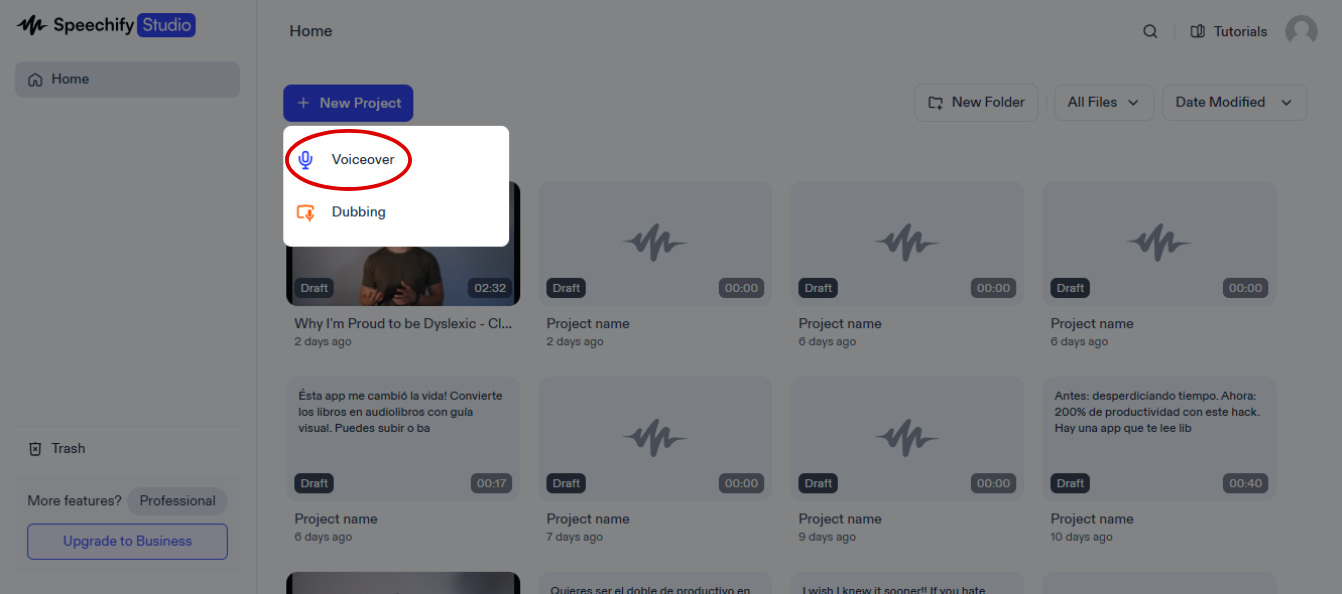
Upload your script: Use the "Import" button to add your script, which Speechify will use to generate the voice over automatically.
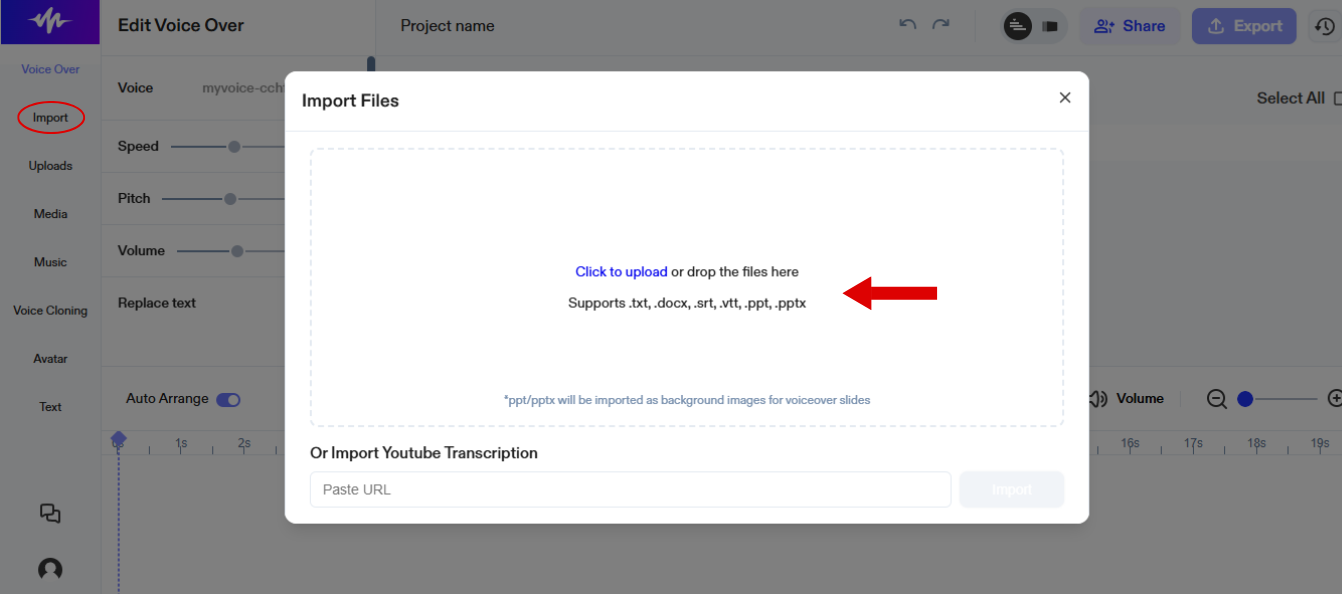
Select an Italian voice: Tap the icon next to your script to browse and choose your preferred voice in Italian, with options to suit various tones and styles.
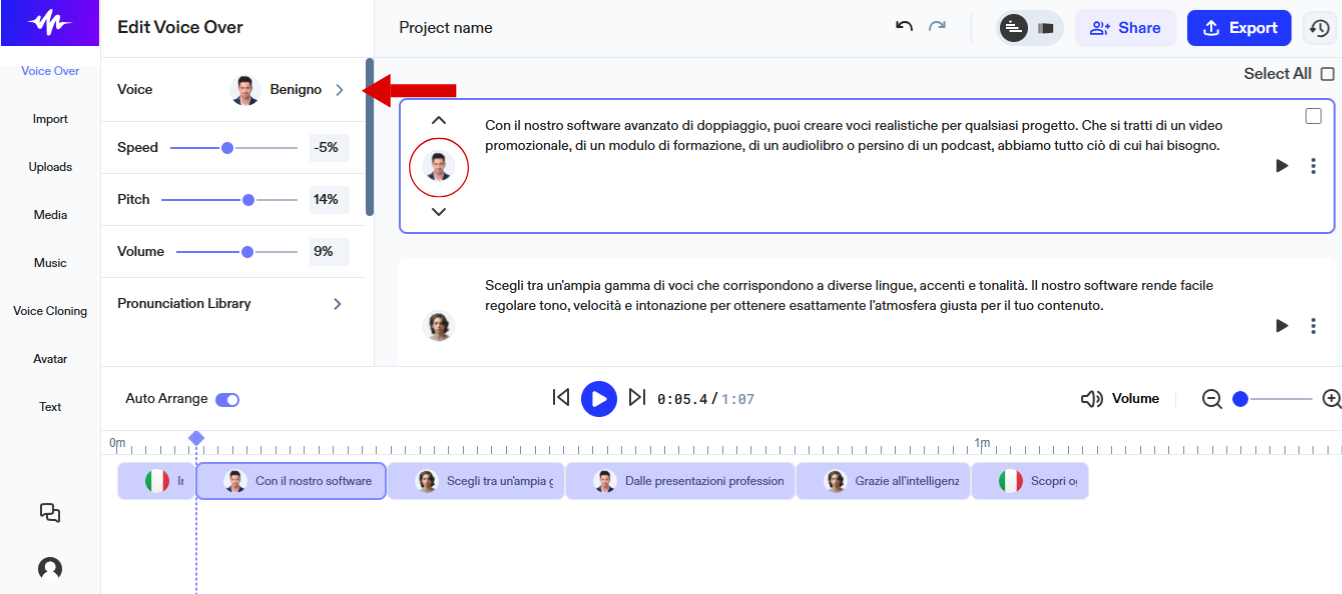
Add media: If needed, go to "Uploads" to add video files or images. You can also explore the "Media" or "Music" tabs to include stock footage or background music to enrich your project.
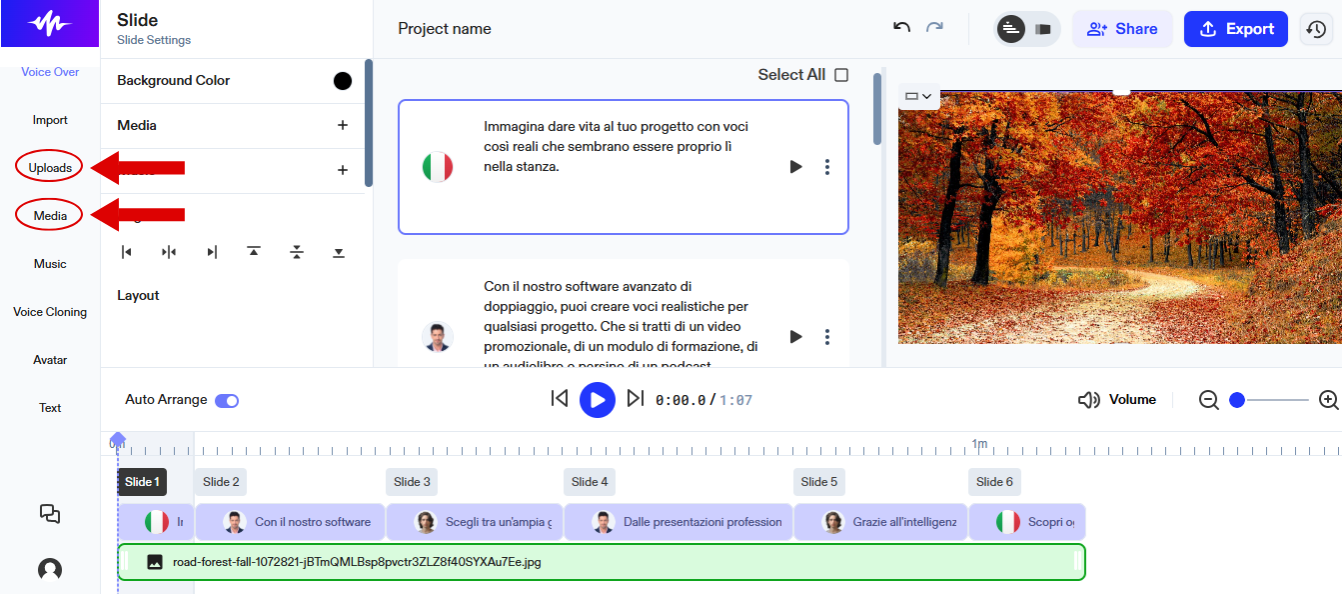
Edit your content: Under "Voice Over," you can adjust pitch, tone, and pronunciation to personalize the audio. Drag and drop elements in the workspace to align video clips or add AI avatars for more visual depth.
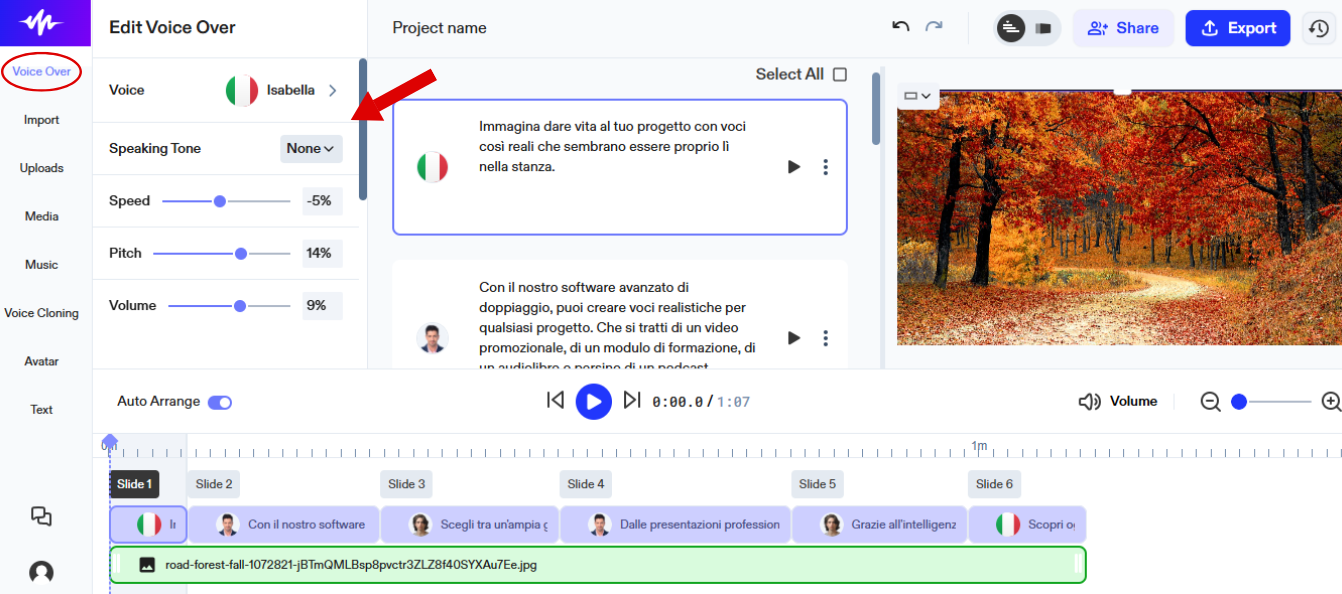
Export your project: When ready, click "Export" and choose your preferred format, such as WAV or MP3.
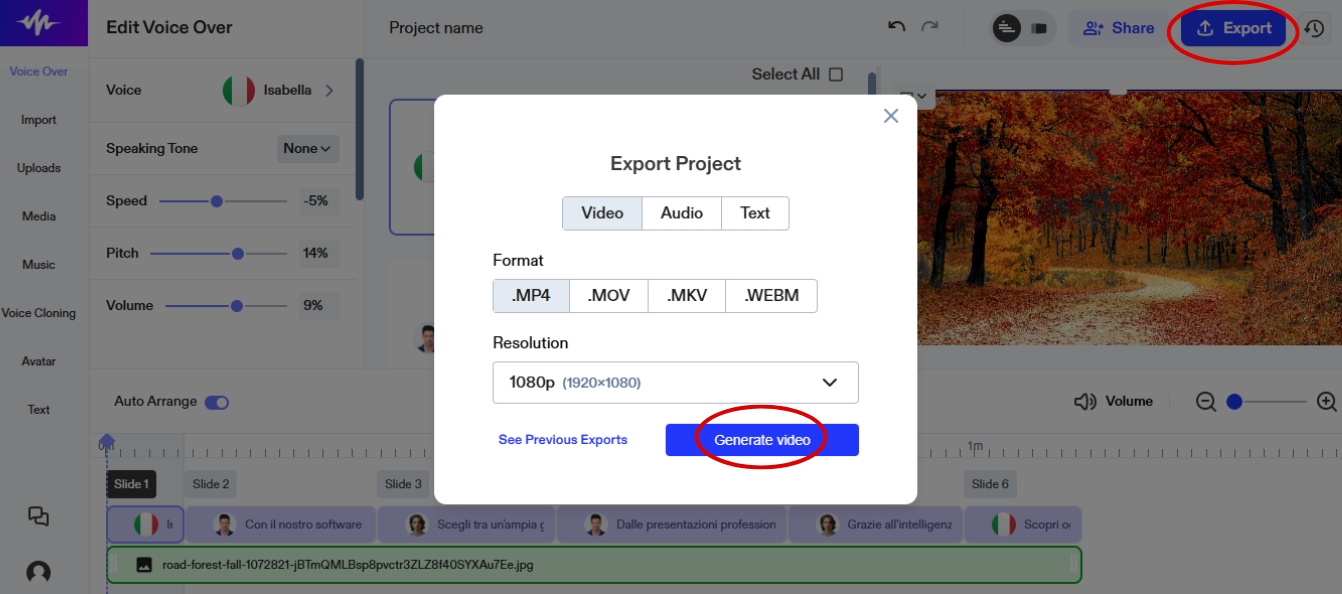
How to Use Speechify Studio’s Italian Voice Cloning
Creating a custom Italian AI voice clone is straightforward in Speechify Studio. Here’s how to create a unique voice based on your own voice:
Launch a new project: Open Speechify Studio and select "New Project." Select “VoiceOver” from the options to access voice features.

Start voice cloning: Click on "Voice Cloning" and select “Create New Voice Clone.”
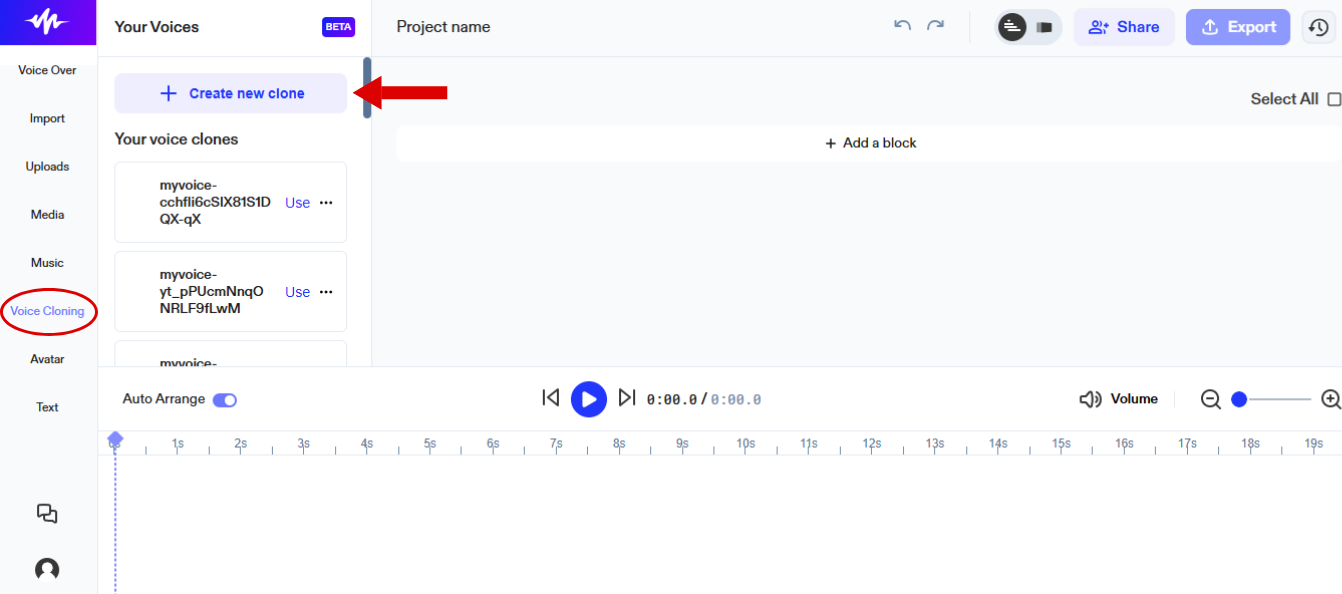
Record a sample: Record a 20-second audio sample of yourself speaking Italian in a quiet setting for optimal accuracy. A live recording is recommended over uploading an existing file.
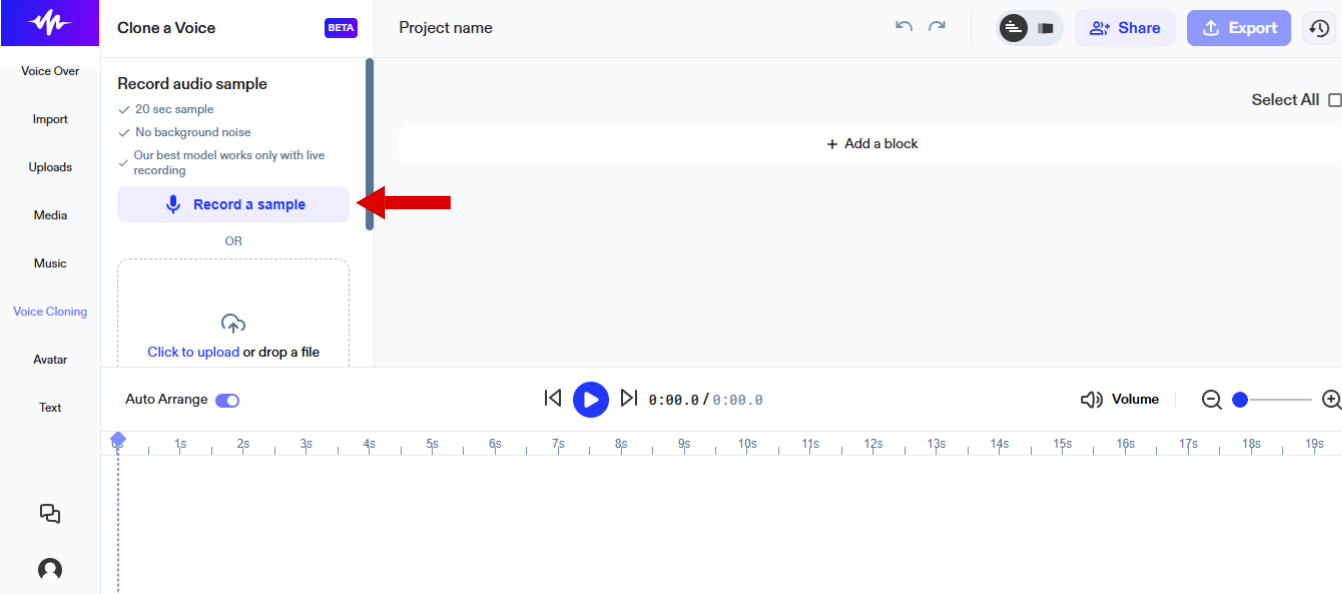
Generate your voice clone: Press “Continue,” and Speechify Studio will process and generate your unique Italian AI voice clone, which will then be available for all your future projects.
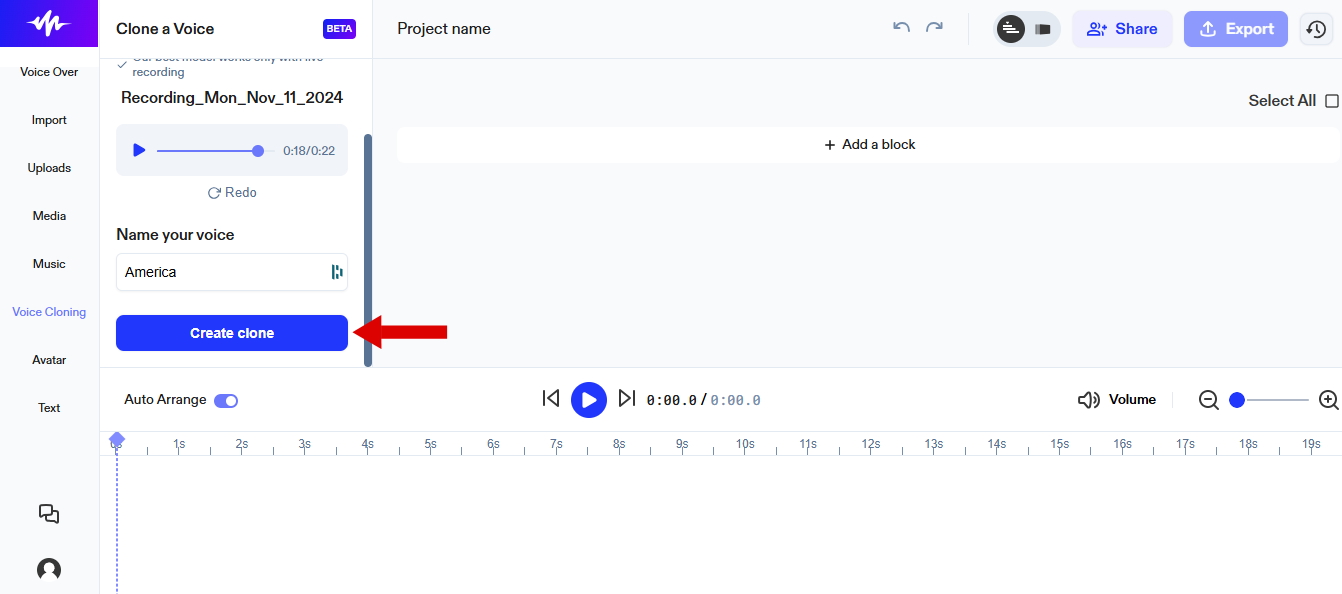
Use your voice clone: To apply your voice clone, follow the same steps as with any standard AI TTS voice. Upload your script and media, select your clone, and Speechify Studio will produce an Italian voice over that sounds just like you.
Most Popular AI Voice Generators for Italian
As Italian content continues to gain popularity, finding the best AI voice generator is key to achieving natural, high-quality results. While Speechify Studio is the overall best Italian AI voice generator, here’s a look at some of the leading Italian AI voice generators, each with its own specialized features to enhance your projects.
Speechify Studio
With over 200 AI voices in 150 languages, Speechify Studio is highly versatile and user-friendly. Its voice cloning feature and AI video editor offer precise control over pitch, tone, and pronunciation, supporting dubbing for Italian projects. Automatic filler-word removal ensures smooth audio, and its API integration makes it adaptable for various applications. A library of stock footage and AI avatars adds visual depth, ideal for professional Italian content creation.
Play.ht
Play.ht supports 142 languages, with high-quality Italian voices and tools for phonetic adjustments to refine flow and clarity. Voice cloning, emotion control, and multi-language support enable authentic, region-specific Italian voice overs tailored to diverse audiences. It’s perfect for creators seeking flexible, lifelike Italian audio in various media.
ElevenLabs
Known for rapid, high-fidelity voice cloning, ElevenLabs is ideal for real-time or fast-paced projects. Its Italian voices are suited to applications needing immediate audio, like live-streaming, without sacrificing quality or naturalness. This efficiency makes it popular for businesses and creators needing quick, realistic Italian voice content.
Descript
Descript’s text-based audio editing simplifies podcast production by allowing users to edit audio via transcript adjustments. For Italian projects, this feature provides precise control over dialogue and structure. With multi-language support, filler word removal, and broadcast-quality output, Descript is valuable for professional creators seeking polished, platform-ready Italian content.
LOVO
LOVO offers 500+ voices, including expressive Italian options with customizable pronunciation, tone, and emotion. Known for storytelling and brand narration, it supports character-driven content and consistent voice quality across projects. LOVO’s advanced voice cloning enables dynamic Italian voice overs that engage listeners through an authentic experience.
Listnr
Listnr’s library of 900 voices in 142 languages includes top-tier Italian voices and robust tools like voice cloning and seamless editing. Especially useful for podcasts, it simplifies production from recording to publishing. The platform’s lifelike Italian voices allow creators to produce compelling audio that resonates with French-speaking audiences across industries.
Murf.ai
Murf offers intuitive controls for creating conversational, engaging Italian voice overs, with options for adjusting pauses, breaths, and pronunciation. Its voice cloning keeps a consistent tone across projects, ideal for creators producing high-quality, relatable Italian content that feels naturally tailored to listeners.
NaturalReader
NaturalReader supports 27 languages with over 200 voices, including Italian. Its pronunciation, pitch, and emphasis adjustments make it versatile for storytelling, educational, and promotional content. With emotional customization, Italian voice overs feel expressive, enhancing narratives for a compelling listening experience.
Synthesys
With 370+ voices across 140 languages, Synthesys provides high-quality, scalable Italian voice overs. Its unlimited downloads feature is great for brands managing large projects, offering Italian voices that maintain engagement in settings like advertising, training, and corporate presentations.
WellSaid Labs
WellSaid Labs’ real-time editing tools across 50 voices provide precise control over Italian voice production. Its nuanced editing is ideal for high-grade Italian audio in industries like broadcasting, training, and customer support, ensuring clarity and authenticity in professional audio.
Respeecher
Respeecher’s advanced voice cloning captures the subtleties of natural speech, ideal for realistic Italian dubbing in film, gaming, and audio dramas. Its detailed voice replication creates immersive Italian experiences suited to audiences seeking high-quality audio fidelity.
Synthesia
Synthesia combines TTS with AI avatars, offering a fully immersive experience for Italian video content. It’s highly valuable for interactive marketing and education, with Italian voice cloning and customizable avatars adding a personal touch to create a rich learning or viewing experience.
Resemble AI
With tools like voice cloning, emotion control, and voice changers, Resemble AI produces nuanced Italian audio. Its strong emotion control allows creators to deliver expressive Italian voice overs, perfect for content needing an emotional connection, such as ads, audiobooks, and interactive media.
Clipchamp
Clipchamp’s 170 voices in 80 languages include unique tools for Italian audio creation, like automatic captioning and a speaking coach. These features support Italian language learning and presentations, enabling clear, authentic Italian-speaking skills in content for greater engagement.
Narakeet
Narakeet offers 600 voices across 90 languages, with options for Italian accents. Integrating with Amazon Polly and Microsoft, it’s ideal for educational or presentation-based content. Narakeet’s ability to match accents ensures Italian audio suited to diverse Italian-speaking audiences’ preferences.
VEED
VEED offers auto-subtitle, translation, and audio tools in 50+ languages, including Italian. Its tone and speed adjustments support well-paced, clear Italian voice overs for content creators. Accurate Italian audio with minimal editing makes VEED effective for instructional videos, social media, and corporate presentations.
Conclusion
With advancements in AI technology, Italian voice generation has become an essential tool for reaching Italian-speaking audiences authentically. From lifelike Italian TTS voices to personalized voice cloning, tools like Speechify Studio provide remarkable flexibility and accuracy for content creation. By enabling region-specific accents and nuanced language adjustments, these AI voice generators make it easier than ever for brands, educators, and content creators to produce high-quality Italian voice overs that resonate with listeners.
FAQ
What is Italian text to speech?
Italian text to speech is a technology that converts Italian text into spoken audio, and Speechify Studio offers a natural and accurate experience.
How do I convert Italian text to speech?
Simply upload or type your Italian text into Speechify Studio, select an Italian voice, and generate your audio instantly.
Which AI voice generator offers the best Italian pronunciation?
Speechify Studio’s AI voice generator provides top-tier Italian pronunciation, delivering authentic, lifelike voices that capture regional nuances.
What is the text to speech app for Italian?
Speechify Studio is the best app for Italian text to speech since it offers the most lifelike Italian AI voices, perfect for creating polished audio for various needs.
What is the best Italian AI text to speech generator?
Speechify Studio stands out as the best Italian AI text to speech generator, combining quality, realism, and customization.
Is there a free Italian AI voice generator?
Yes, Speechify Studio offers a free Italian text to speech generator so you can try its Italian AI voice capabilities without subscribing to its premium pricing plans.





